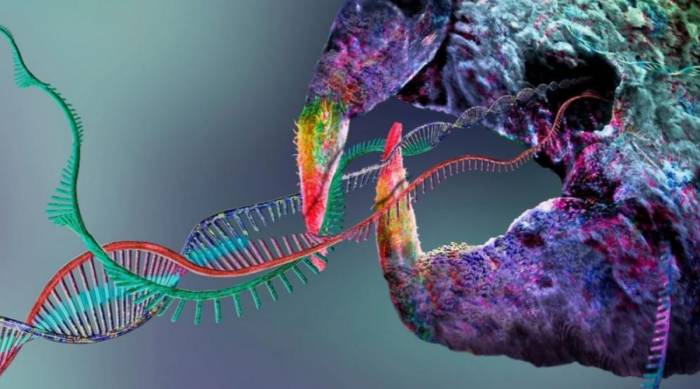Recently, geneticists at the University of California, San Francisco (UCSF) have successfully used CRISPR-Cas gene-edited fat to shrink tumors in mice, and scientists involved believe that one day this technology may play the same role in humans.
Transgenic fat can be transplanted into mice to reduce both mouse and transplanted human tumors, but this novel cancer treatment method still needs to be tested in human trials.
Scientists have used the gene-editing tool CRISPR to extract and modify fat from the body, which can be used to treat cancer. This has been confirmed by a study conducted by geneticists at UCSF on mice and transplanted human cancer tissues. However, the safety and efficacy of this new experimental therapy in humans remain to be seen.
The latest research indicates that "white fat" extracted from the body can be reprogrammed to mimic "brown fat" through CRISPR-Cas gene-editing technology, and then introduced into rodents to reduce tumors.
In the human body, white fat is used to store excess energy, while brown fat heats the body by breaking down blood sugar or glucose. Scientists have found that this function of brown fat can be used to deprive tumors of the nutrients they need to grow.
Obesity caused by the accumulation of white cells
Advertisement
The study used white fat extracted from humans and mice, as well as tumor cells transplanted from humans and mice, to verify this hypothesis.
The accumulation of white fat in the body significantly increases the number of cells and has the potential to transform into cancer, which also explains why an increase in body weight correspondingly raises the risk of developing cancer.
This study involving mice and human cancer patients indicates that while it is known that white fat increases the risk of cancer, brown fat can reduce tumors.Research indicates that low temperatures can cause brown adipose tissue to excessively absorb glucose, thereby depriving cancer cells of the nutrients they need to survive.
Geneticists at the University of California, San Francisco (UCSF), have developed this therapy in mice and named it Adipose Modulation Transplantation (AMT).
The method involves transforming white fat into a brown-like "beige" fat in vitro by activating the genes required for "browning."
The team has tested Adipose Modulation Transplantation (AMT) in mouse models of breast cancer, colon cancer, pancreatic cancer, and prostate cancer, finding that the implantation of beige fat leads to a reduction in the size of all these tumors by more than half.
The head of the experiment, Professor Nadav Ahituv from the UCSF School of Pharmacy and a senior researcher, stated in a declaration that the Adipose Modulation Transplantation (AMT) technology can work in conjunction with other cancer treatment methods.
However, more clinical trials are needed to monitor whether the implantation of beige fat will raise body temperature to fever levels or cause other side effects that the human body cannot tolerate. Professor Ahituv has already applied for a patent for the Adipose Modulation Transplantation (AMT) technology.
Brown adipose tissue is typically located in the neck area of mice and humans, but despite the neck being distant from the body's fat accumulation areas, experiments have found that tumors in the breast, skin, and pancreas are also inhibited.
Professor Ahituv and his team discovered that the implantation of beige fat on the back can also produce a similar long-distance effect, at least for breast cancer.
In their other experiments, the team transplanted beige fat into mice, bringing it close to the transplanted tumor cells similar to those in the human colon, pancreas, and prostate, so they still need to confirm whether this fat can also have a long-distance effect on such tumors.

Professor Ahituv believes that CRISPR-Cas gene-edited fat can be implanted during pre-scheduled cancer surgeries, such as mastectomies.Gene editing is commonly used in gene therapy and cancer treatments such as CAR T-cell therapy, so Ahituv anticipates that the use of CRISPR gene-editing technology in Adipose Modulation Transplantation (AMT) will not affect the application of this therapy in human patients.
Currently, Adipose Modulation Transplantation (AMT) has only been tested in mice and in laboratory-cultured breast tumor samples from human cancer patients, so its efficacy and safety in humans can only be reasonably speculated upon before clinical trials are conducted.
However, some studies suggest that in cancer patients, brown fat may sequester nutrients from healthy cells and lead to cachexia, a wasting syndrome associated with the disease.
Researchers at the University of California, San Francisco (UCSF) did not observe weight loss in mice over a period of six weeks, but Professor Ahituv believes that the possibility of cachexia occurring later cannot be ruled out, so it is necessary to conduct longer-term studies.
Professor Ahituv plans that the next step for researchers is to calculate the amount of fat to be implanted in each patient and determine what would be considered excessive, ideally with the option to remove the implant after a period or install a "kill switch" to prevent them from continuing to consume nutrients from healthy cells.
Comments